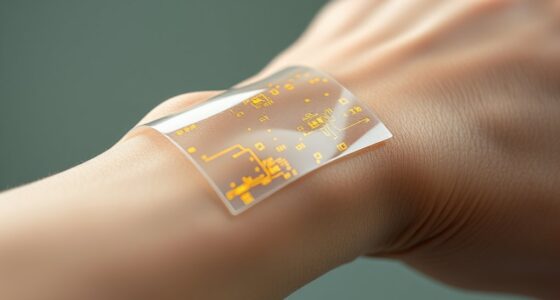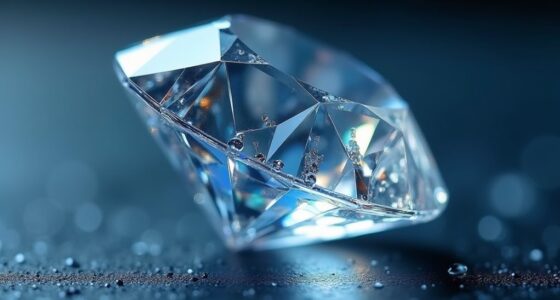You’ll find that liquid crystal technology now powers smart windows that automatically tint themselves, offering privacy, energy efficiency, and better indoor comfort. These windows respond instantly to electrical signals, adjusting transparency to block sunlight or reduce heat gain. You can control them manually or set them to respond automatically to environmental conditions. This innovative use of liquid crystals helps save energy and enhances aesthetic appeal—continue exploring how these advanced windows can transform your space.
Key Takeaways
- Liquid crystal smart windows automatically adjust their tint to control light, heat, and privacy without manual intervention.
- They enhance energy efficiency by reducing reliance on heating and cooling systems through adaptive shading.
- These windows offer instant privacy by switching from transparent to opaque, eliminating curtains or blinds.
- Integration with automation systems allows for scheduled or environmental-responsive tinting, optimizing indoor comfort.
- Their sleek design and environmental benefits support sustainable building practices and modern aesthetic preferences.

Smart windows that utilize liquid crystal technology are transforming how we control indoor lighting and temperature. Instead of relying on traditional blinds or curtains, these windows can change their tint at the flick of a switch or automatically in response to environmental conditions. This innovation offers a significant boost to energy efficiency because it helps regulate indoor temperatures without extra heating or cooling.
Liquid crystal smart windows automatically adjust tint to improve energy efficiency and indoor comfort.
By reducing the need for air conditioning or heating, you save on energy bills and lessen your carbon footprint. Plus, since you can adjust the tint precisely when needed, you maintain a comfortable environment while minimizing energy waste.
Privacy control is another key advantage of liquid crystal smart windows. When you want privacy, you can instantly switch the glass from transparent to opaque, blocking the view from outside without the need for curtains or shutters. This is especially useful in homes or offices located in busy areas or exposed to prying eyes.
The technology allows for seamless, instant control, so you don’t have to compromise on natural light or aesthetics. Whether you’re working from home, relaxing, or entertaining guests, you get privacy on demand without sacrificing style or convenience.
The way these windows work is fascinating. Liquid crystal molecules inside the glass respond to electrical signals. When you activate the switch, these molecules realign, changing the window’s transparency.
In their default state, the crystals are aligned to let light pass through, giving you a clear view. When powered, they reorient to block light, creating a tinted or opaque appearance. This process is quick, efficient, and silent, making it practical for daily use.
You can program these windows to adjust automatically based on sunlight levels or temperature, further enhancing your control over indoor conditions and reducing reliance on energy-consuming climate control systems.
Moreover, these smart windows are versatile and adaptable. They can be integrated with home automation systems, allowing you to set schedules or respond to weather conditions automatically.
As a result, your living or working space becomes smarter, more energy-efficient, and more private. This technology not only elevates comfort but also aligns with sustainability goals, making it an attractive choice for environmentally conscious individuals.
In short, liquid crystal smart windows are revolutionizing the way you manage your indoor environment, offering customizable privacy and improved energy efficiency in a sleek, modern package. Additionally, understanding the contrast ratio of these windows helps in assessing their effectiveness and visual performance.
Frequently Asked Questions
How Long Do Smart Window Liquid Crystals Typically Last?
Smart window liquid crystals typically last around 10 to 20 years, depending on various longevity factors. You should consider durability testing results, which show how well these crystals withstand exposure to sunlight, temperature fluctuations, and environmental conditions.
Proper maintenance and high-quality materials can extend their lifespan. Keep in mind that regular inspections can help you identify any signs of wear or fading early, ensuring your smart windows remain effective over time.
Are Self-Tinting Windows Energy Efficient?
Did you know that smart windows can cut energy costs by up to 40%? Self-tinting windows are highly energy efficient because they automatically adjust to sunlight, reducing the need for artificial cooling or heating.
They harness solar energy to optimize indoor comfort and provide privacy protection without curtains or blinds. So, yes, these windows save energy and help you stay comfortable, all while protecting your privacy seamlessly.
Can Liquid Crystal Smart Windows Be Customized in Size and Shape?
You might wonder if liquid crystal smart windows can be customized in size and shape. The good news is that they offer great customization options, thanks to their shape flexibility.
You can tailor these windows to fit specific spaces or design preferences. Manufacturers can produce them in various sizes and shapes, making it easy to integrate smart windows seamlessly into your building or project.
This customization provides both functionality and aesthetic appeal.
What Maintenance Is Required for These Smart Windows?
Think of your smart windows as a delicate garden needing care. To keep them shining, you should follow simple cleaning procedures—use a soft cloth and avoid harsh chemicals.
Regularly check for any damage and adhere to replacement guidelines if needed. This gentle upkeep guarantees your windows stay clear and responsive, like a well-tended garden, providing seamless tinting and energy efficiency for years to come.
Are There Any Health Concerns With Liquid Crystal Windows?
You might wonder about health safety with liquid crystal windows. Generally, they’re safe because they don’t emit harmful chemicals during use, and chemical exposure is minimal.
However, if a window breaks, small liquid crystal particles could be released, so handle damage carefully.
Conclusion
As you gaze through these smart windows, it’s almost poetic how liquid crystals have quietly transformed our world. What began as a technology for screens now unexpectedly tints buildings, blending science with everyday life. It’s as if the very materials designed for one purpose found a new, elegant way to brighten our environments—without you even noticing. This coincidence reminds you that innovation often happens when different ideas unexpectedly intersect, creating a future where your surroundings adapt effortlessly to your needs.









